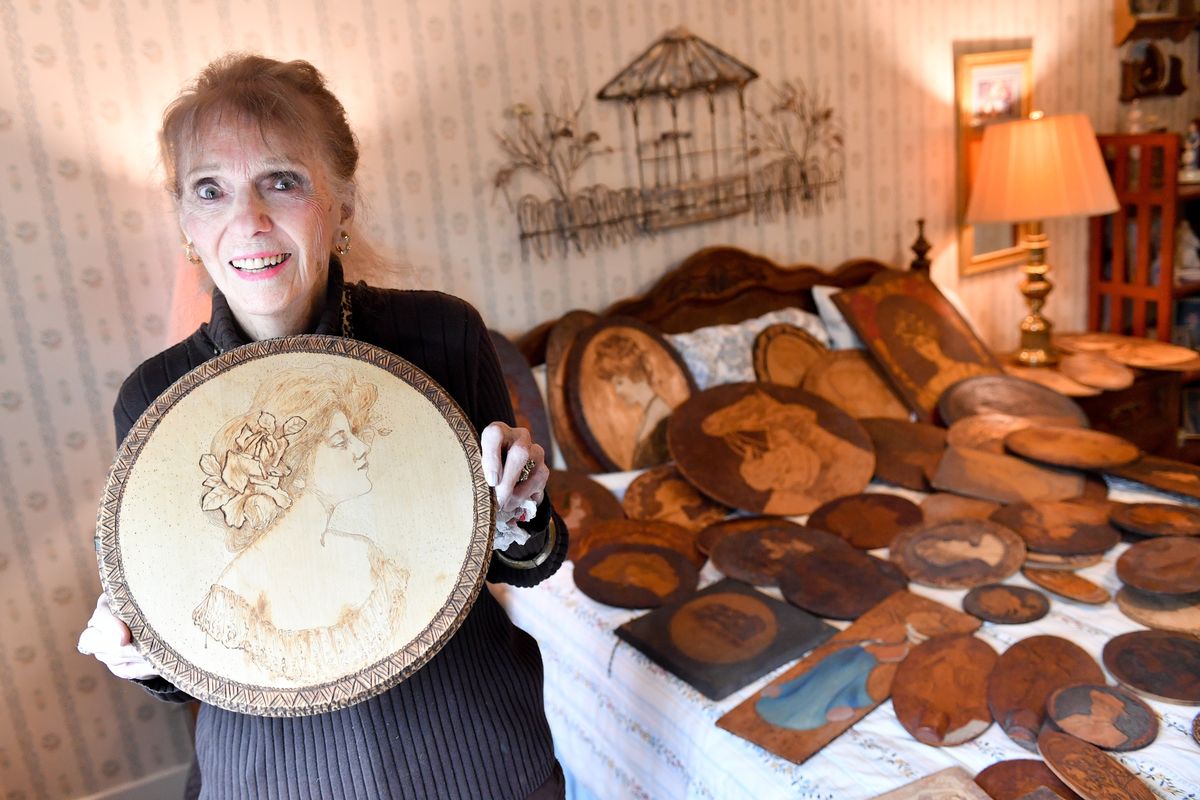The collector: Marilyn Akerhielm

Thirty years ago, Marilyn Akerhielm spotted a wooden plaque while browsing at an antique shop on North Monroe. The winsome profile of a Gibson Girl captivated her.
“The shop owner said, ‘Do you like it? I have another one,’ ” Akerhielm said.
And just like that, a collection was born.
She discovered the technique used to create the piece was pyrography (also known as woodburning) – an art form that’s existed for centuries.
It’s an age-old technique in which a heated metal pen or other implement is used to burn wood, leaving behind a decorative pattern.
Akerhielm scoured antique stores and e-Bay where she initially found many examples of pyrography.
She decided to focus most of her collection on plaques, boxes and hand mirrors bearing the likeness of the Gibson Girls and on women and girls depicted in the Art Nouveau style.
“I’m just crazy about Gibson Girls and their beautiful profiles,” she said. “My dad had an automobile parts place and he’d get calendars featuring them.”
Artist Charles Dana Gibson sketched these models of American beauty during a 20-year period that spanned the late 19th and early 20th centuries.
As Akerhielm added to her collection, she discovered most of her pieces were made from home craft kits produced by the Flemish Art Co. in New York.
At the turn of the 20th century, the invention of pyrography kits for home use popularized the craft.
The Flemish Art Co.of New York was one of the first companies to supply these new tools, so much so that the name, “Flemish Art” became a generic term for pyrography.
The kits were promoted and sold in catalogs and women’s magazines as a good pastime for women. Typically, small items like plaques, picture frames and handkerchief boxes were made, but large furniture pieces like chests, cabinets and chairs were also burned.
Pyrography kits came with a stamped item, a woodburning tool and sometimes watercolor paints. They typically cost a dollar or less. The resulting homemade art was often given as gifts. That’s why items in Akerhielm’s collection feature handwritten inscriptions on the backs. Reading them offers a glimpse of turn-of-the-century life.
One plaque reads “From Ernestine to Edith, 1909.”
A large oval depicting a Native American woman reads, “A prescription from Dr. Sahlberg.”
On the back of a religious-themed piece, someone wrote, “Burned by Grandma Hahn, 1910.”
It still has the original Flemish Art price tag of 44 cents affixed to it.
Speaking of price tags, Akerhielm said she didn’t set a price limit when looking to add pieces.
“But I don’t think I ever spent over $100,” she said.
There are a few duplicates in her 225-piece collection, but they’re not identical because each artist burned the wood in their own style.
In addition to the decorative pieces depicting women of a bygone era, her selection of heavy wooden hand mirrors with intricate designs, hearkens back to a time long before lighted makeup mirrors existed.
Akerhielm, 91, appreciates the unique artistry of pyrography.
“I grew up an artist,” she said. “I wanted to be a dress designer, but Dad wouldn’t let me go to New York to study fashion design.”
Instead, she stayed closer to home and worked as an American Society of Interior Designers certified interior designer.
She doesn’t anticipate adding to her collection because while there are still examples of pyrography out there, her focus is narrowly on the Art Nouveau and Gibson Girl pieces.
“I’ve looked on e-Bay, but can’t find any more,” Akerhielm said.
“I think I bought them all!”